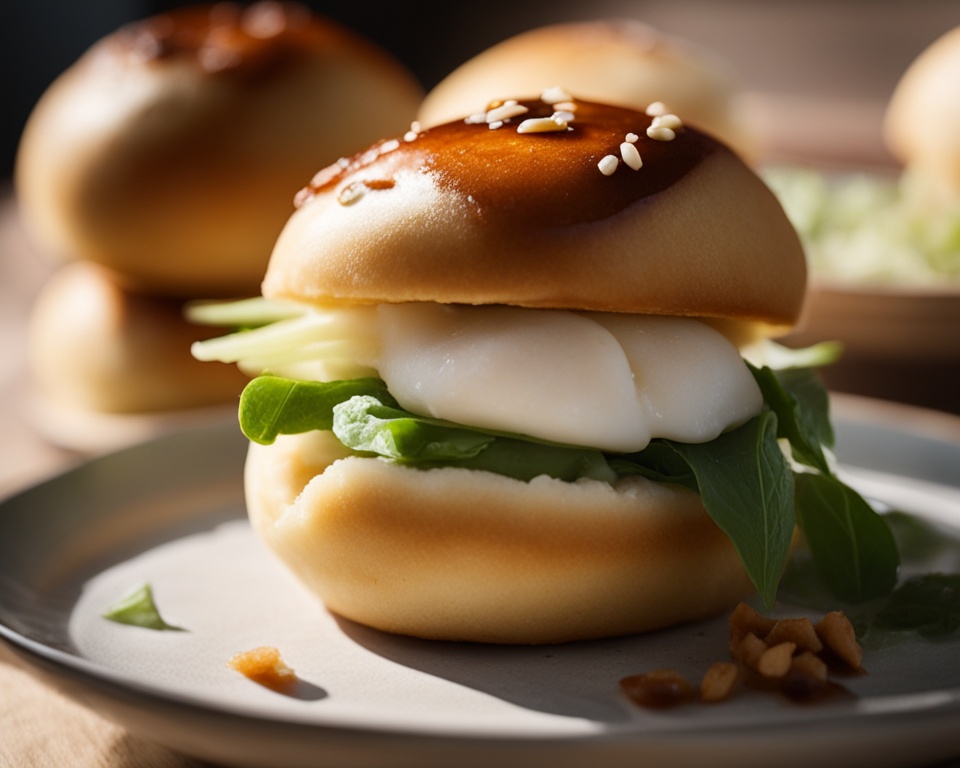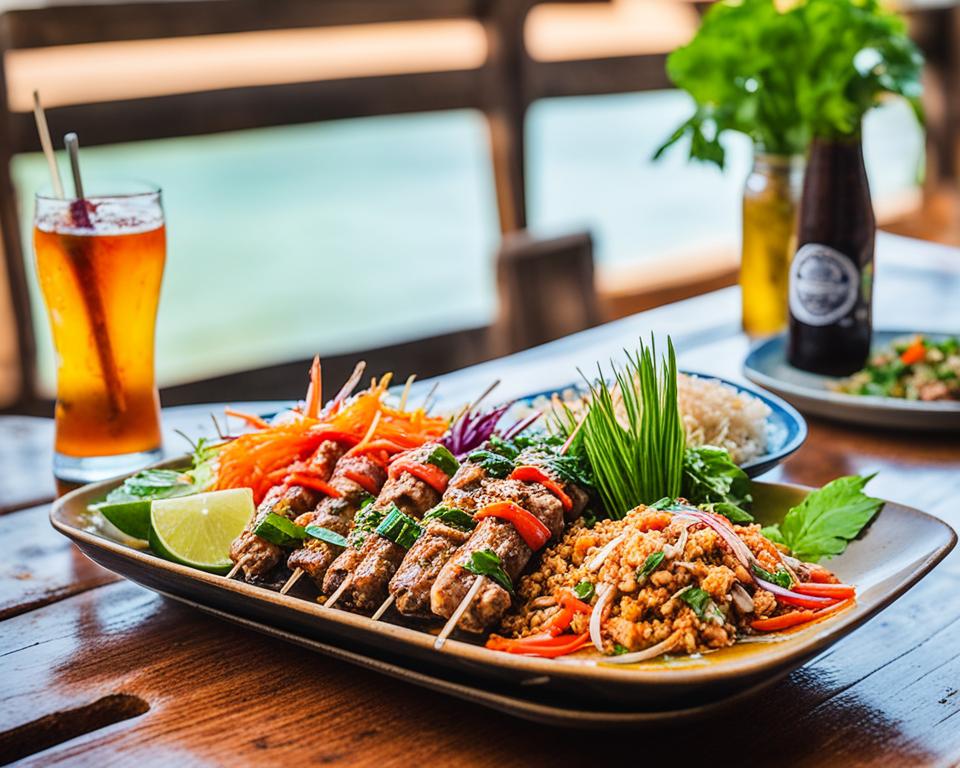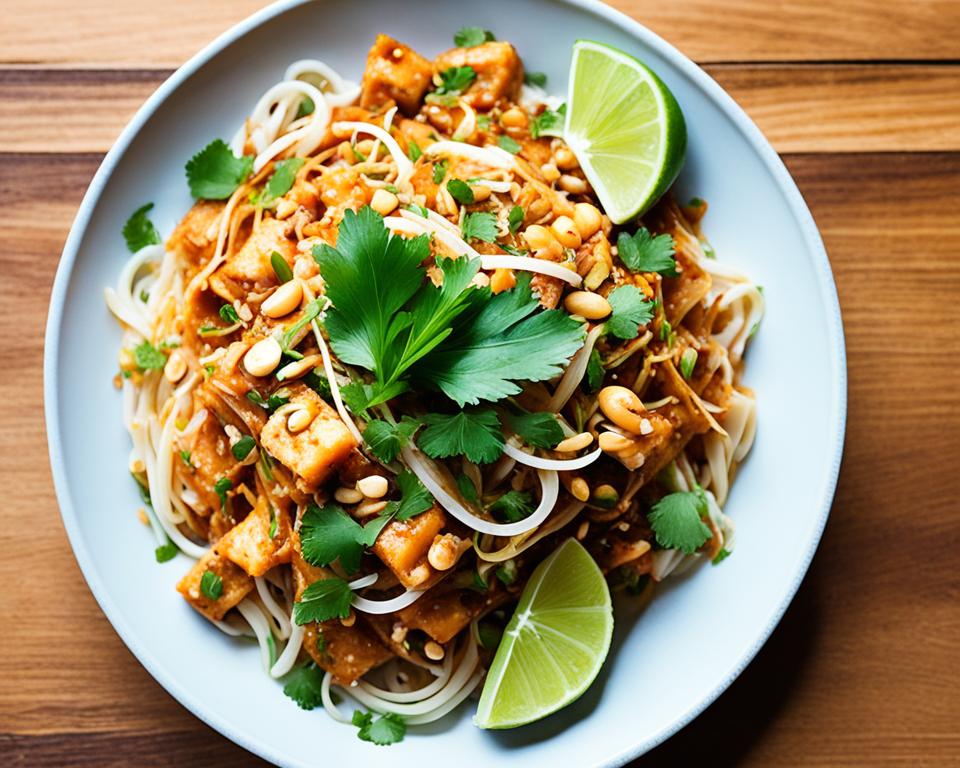Get ready to enjoy the amazing taste and smell of gluten free bao buns. These soft, allergy-friendly Asian snacks are perfect for those who can’t have wheat. Learn how to make gluten-free dumplings that taste just like the real thing.
This guide will take you through the history of wheat-free steamed buns. You’ll also learn about the health perks of celiac-friendly bao. Plus, you’ll get a step-by-step guide to making grain-free dim sum. Our recipe is perfect for any filling, whether you want something savory or sweet.
Explore the world of low-gluten bao recipe and discover how to make gluten-free flour bao at home. Impress your loved ones with your baking skills and enjoy the tasty goodness of these gluten free bao buns.
Read more interesting information at ::lansdowne-moody
Introducing Gluten Free Bao Buns
If you have wheat sensitivities or celiac disease, Asian cuisine might seem out of reach. But, gluten-free bao buns offer a solution. These soft, tasty buns are perfect for those who can’t have wheat. They let everyone enjoy this comforting food.
A Delightful Alternative for Wheat Sensitivity
Gluten-free bao buns are a big deal for people with wheat allergies or intolerances. Made with gluten-free flours, they are soft and pillowy. This makes it easy to enjoy the classic Asian delicacy without worrying about symptoms.
Fluffy, Flavorful, and Allergen-Friendly
These gluten-free bao buns are the opposite of what you might think. They’re light, airy, and full of flavor. So, people with dietary restrictions can enjoy the same tasty experience as others.
| Ingredient | Gluten-Free Bao Buns | Traditional Wheat-Based Bao |
|---|---|---|
| Flour | Gluten-free flour blend | All-purpose wheat flour |
| Allergens | Allergen-friendly, suitable for those with wheat sensitivities | Contains gluten, not suitable for those with celiac disease or wheat allergies |
| Texture | Soft, fluffy, and pillowy | Soft, chewy, and slightly doughy |
“Gluten-free bao buns have been a game-changer for me. I can now enjoy the comforting flavors of Asian cuisine without worry or discomfort.”
The History of Bao Buns
Bao buns are fluffy, pillowy delights with a long history. They started in ancient China and have become a comfort food worldwide. These Asian steamed buns are loved by many.
The first records of bao buns come from the Song Dynasty. They were a hit as street food. These soft buns were filled with tasty meats, veggies, and sauces. They were a great meal for workers.
Over time, the recipe and how they were made got better. This led to the many types of bao buns we enjoy today.
Bao buns are important in many Asian cultures. They’re linked to festivals, celebrations, and family time. Sharing bao buns is a tradition that goes back generations.
“Bao buns are not just a delicious food, but a reflection of the rich history and diverse culinary traditions of Asia.”
As bao buns became popular around the world, people started to get creative. Chefs and cooks tried new fillings and flavors. Now, you can find everything from classic barbecue pork to vegan options.
The lasting impact of bao buns shows their importance in culture and food. They’re enjoyed as a simple snack or a fancy meal. These steamed treats are a key part of the history of bao buns and origins of Asian steamed buns.
Benefits of Gluten-Free Bao Buns
Gluten-free bao buns are great for health lovers who want to avoid allergens. They are soft and taste like traditional Asian breads. These buns are perfect for people who can’t eat wheat and are looking for a healthy bread option.
Allergen-Free Indulgence for All
Gluten-free bao buns are made with love, so everyone can enjoy their delicious taste and texture. They use flours like rice, tapioca, or millet, so they don’t have gluten. This makes them safe for people with celiac disease or gluten intolerance.
So, people with dietary restrictions can enjoy these buns without worry. They’re a great choice for any gathering.
Nutritious and Wholesome Ingredients
These bao buns are not only safe for allergens but also packed with nutrients. They often include whole foods like brown rice flour, tapioca starch, and coconut milk. This makes them a better choice than regular buns made with refined wheat flour.
They’re a great Asian bread option for a healthy diet. The mix of being allergen-free and nutritious makes them perfect for those looking for the benefits of gluten-free bao and the nutritional value of allergen-free bao. They’re ideal for any event or just a tasty, healthy bread choice.
Key Ingredients for Gluten Free Bao Buns
Making delicious gluten-free bao buns starts with picking the right gluten-free flours. There are many options to choose from. This can help you make the bao buns light and fluffy.
Exploring Gluten-Free Flours
Choosing the right flour is key in gluten-free baking. Rice flour is a top choice because it tastes neutral and makes the dough tender. Tapioca starch adds a chewy texture. Almond flour brings a nutty flavor and more nutrition.
Try mixing these flours to find the best blend for bao buns. The right mix makes the dough easy to work with and gives you soft, fluffy buns. Learn how to pick the right gluten-free flour for bao, ingredients for allergen-free asian bread, and best flours for wheat-free steamed buns to become a pro at making gluten-free bao.
| Gluten-Free Flour | Key Properties | Recommended Usage |
|---|---|---|
| Rice Flour | Neutral flavor, tender texture | Primary flour base for bao |
| Tapioca Starch | Chewy, stretchy quality | Enhances dough structure and elasticity |
| Almond Flour | Nutty taste, added nutrition | Can be used in small amounts for flavor and nutrition |
“The secret to perfect gluten-free bao buns lies in the right flour blend. Experiment with different combinations to find the perfect balance of lightness, chewiness, and flavor.”
Step-by-Step Guide to Making Gluten Free Bao Buns
Making gluten-free bao buns at home is simpler than it seems. With the right tools and a few easy steps, you can make these soft, allergy-friendly Asian treats at home. This guide will help you make these buns from start to finish, whether you’re on a gluten-free diet or just want a healthier option.
Essential Tools and Equipment
To begin, you’ll need a few important items:
- A steamer basket or pot with a tight-fitting lid
- A mixing bowl and wooden spoon or stand mixer
- A rolling pin for shaping the dough
- A sharp knife or scissors for cutting the dough
- Parchment paper or a silicone baking mat for shaping the buns
With these tools ready, you’re set to learn how to make gluten-free bao, create celiac-friendly steamed buns, and make wheat-free Asian bread at home.
After getting your tools, it’s time to mix your gluten-free bao dough. With a few simple ingredients and some time, you’ll soon enjoy these tasty, allergy-friendly treats.
Mastering the Perfect Bao Dough
Making the perfect gluten-free bao dough is key to getting light, fluffy, and tasty steamed buns. If you want to make wheat-free bao batter or improve the texture of allergen-free steamed buns, getting the bao dough right is crucial.
One important step is finding the right mix of flours. Try different gluten-free flour blends like rice flour, tapioca starch, and potato starch. This can help you find the perfect mix for gluten-free bao dough.
Another key part is kneading the dough. Kneading well helps shape the dough’s structure. It traps air pockets, making the buns fluffy inside. Knowing how to knead and when is important for ideal texture in allergen-free steamed buns.
“The key to perfect bao dough lies in finding the right balance of flours and mastering the art of kneading. With a little practice, you’ll be on your way to creating delightfully fluffy and flavorful gluten-free bao buns.”
Follow these tips for gluten-free bao dough to make light and airy bao buns. These buns are great for everyone, even those with dietary restrictions.
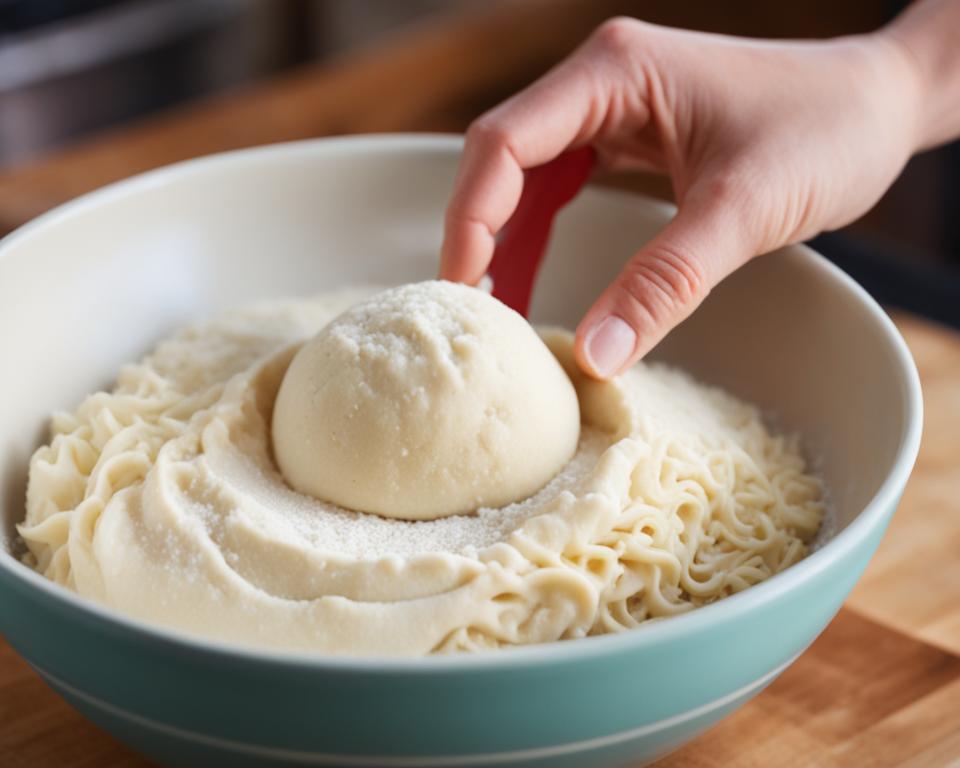
Shaping and Folding Techniques
Learning how to shape and fold gluten-free bao buns is key to getting that classic look and feel. Discover the traditional bao folding methods and how to use them for your allergy-friendly buns.
Traditional Bao Folds Demystified
The classic pleated bao is a favorite, but there are more bao folding techniques to try. These include the delicate crescent shape and the complex flower fold. Learning these methods lets you make gluten-free bao buns that look great and taste amazing.
- The Classic Pleated Bao: Pinch and fold the dough to create elegant, uniform pleats along the edges.
- The Crescent Bao: Gently shape the dough into a crescent moon-like form for a unique, delicate appearance.
- The Flower Bao: Expertly fold and pleat the dough to mimic the petals of a blooming flower.
With practice, you’ll master these traditional bao folding techniques. You’ll be able to make gluten-free bao buns and allergen-free Asian dumplings that look and taste great.
Steaming Secrets for Fluffy Bao Buns
Learning how to steam is key to making those fluffy bao buns you love. Gluten-free doughs need special care when steaming. Here are the secrets to perfect steaming and making sure your Asian-inspired breads are always cooked right.
The Right Steamer Setup
For fluffy, wheat-free steamed buns, start with the right steaming tools. Use a bamboo or metal steamer basket with parchment paper or cabbage leaves to prevent sticking. The basket should fit well inside your pot or wok, leaving space for steam to move around.
Water Level and Timing
- Fill the pot or wok with water to create a steady steam, but don’t let it touch the buns.
- Get the water simmering before adding your buns. Steaming should take 10-12 minutes for gluten-free bao.
- Don’t look during steaming, as it can make the buns fall flat.
With these tips, you’re on your way to making perfect allergen-free Asian bread. You can now enjoy fluffy, tasty bao buns even on a wheat-free diet.
Gluten Free Bao Buns Variations and Fillings
There’s more to bao buns than just the classic kind. Explore gluten-free variations and creative fillings. From traditional pork to vegetarian and sweet options, there’s a lot to try.
Sweet and Savory Delights
Enjoy the mix of sweet and savory with these gluten-free bao bun fillings:
- Slow-Roasted Pork Belly: Tender pork chunks in Asian spices and sauces.
- Barbecue Pulled Chicken: Shredded chicken in tangy, smoky barbecue sauce.
- Ginger Tofu: Crispy tofu cubes with a ginger-garlic sauce.
- Red Bean Paste: Sweet filling made from azuki beans, great for dessert bao.
- Coconut Custard: A creamy, tropical twist on traditional bao buns.
Gluten-free bao buns are very versatile. Try different fillings to make sweet and savory bao that fit various diets and tastes.
“Bao buns are the ultimate comfort food, and going gluten-free doesn’t mean you have to miss out on the deliciousness.”
Serving and Presenting Gluten-Free Bao Buns
Serving your gluten-free bao buns right is as important as baking them. These soft, allergy-friendly treats look great when displayed well. You can use traditional bamboo steamers or modern platters to show off your wheat-free steamed buns.
Traditional Serving Styles
For a true Asian look, serve your gluten-free bao buns in a bamboo steamer. Put the buns in a single layer to highlight their softness. You can also stack them for a cool look. Serve with small bowls of sauces for dipping, making the allergen-free asian bread even better.
Modern Platter Presentations
For a bold look, put your how to serve gluten-free bao buns on a stylish platter. Arrange them neatly, with fresh herbs or colorful dips around them. This modern way not only shows off the buns but also invites guests to try different flavors and textures.
- Add edible flowers for a beautiful touch.
- Use pickled radishes or sautéed greens for a balanced look.
- Give guests small plates to make their own presentation ideas for allergen-free asian bread.
Any way you serve gluten-free bao buns, focus on their special qualities. With creativity and care, you can turn these tasty and allergen-friendly treats into a memorable meal.
“Serving gluten-free bao buns is an opportunity to showcase their delicate texture and diverse flavors. Get creative and let your presentation do the talking!”
Storing and Reheating Tips
Enjoying homemade gluten-free bao buns is a treat. But keeping them fresh can be tricky. With the right storage and reheating, you can keep your allergen-free Asian bread tasty for days. Let’s look at how to store gluten-free bao buns, reheating tips for wheat-free steamed buns, and maintaining freshness of allergen-free asian bread.
Refrigerating and Freezing Gluten-Free Bao Buns
Act fast to store your bao buns. Once they cool down, put them in an airtight container or a resealable bag. Keep them in the fridge for up to 3 days. If you want to store them longer, freeze them. Put them in a single layer on a baking sheet, then move them to a freezer-safe bag or container once they freeze.
Reheating Gluten-Free Bao Buns
There are easy ways to reheat your bao buns and keep them soft. For buns in the fridge, steam them for 2-3 minutes. Frozen buns need 5-7 minutes of steaming. Or, you can microwave them for 30-60 seconds, but be careful not to overheat.
By using these storage and reheating tips, you can enjoy your gluten-free bao buns for a long time.
Gluten-Free Bao Buns for Special Diets
Gluten-free bao buns are a treat for those with gluten sensitivities. They are also great for people following other special diets. These buns are versatile and inclusive, fitting a wide range of dietary needs and likes.
For those with celiac disease or gluten intolerance, bao buns without gluten are a safe choice. They use gluten-free flours like rice flour or tapioca starch. This makes them as fluffy and tasty as regular bao buns.
Allergen-friendly bao also suit other dietary needs. People with nut allergies or soy sensitivities can enjoy these buns. They can be made without these allergens. Vegans and vegetarians have many savory and sweet filling options to choose from.
| Dietary Needs | Gluten-Free Bao Bun Adaptations |
|---|---|
| Gluten Intolerance | Gluten-free flours, such as rice flour or tapioca starch |
| Nut Allergies | Nut-free fillings and toppings |
| Soy Sensitivities | Soy-free sauces and condiments |
| Vegan/Vegetarian | Plant-based fillings and savory or sweet options |
With creativity and attention to dietary needs, wheat-free Asian bread options like gluten-free bao buns are for everyone. They are inclusive and delicious for a diverse group of people.
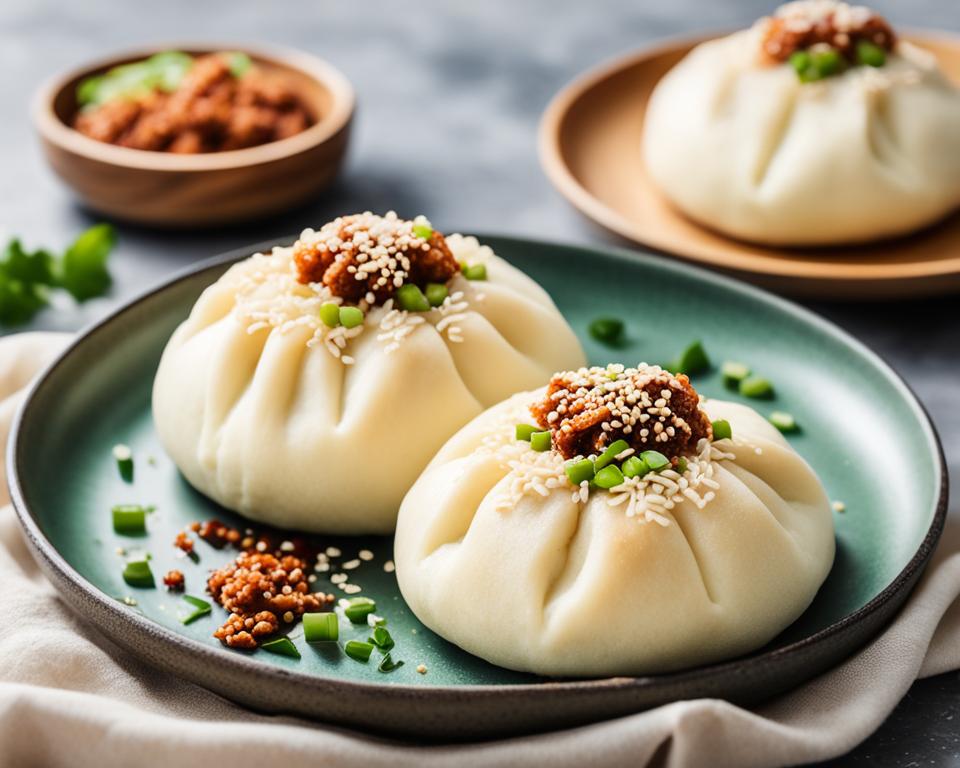
Troubleshooting Common Issues
Making perfect gluten-free bao buns can be fun but also a bit tricky. There are ways to fix common problems and get fluffy results every time. Whether you’re just starting or have been baking for a while, knowing how to solve these issues can make your buns turn out great.
Ensuring Perfect Bao Every Time
A common issue with gluten-free bao is a dense, heavy texture. This might happen if you over-knead the dough or use the wrong gluten-free flour mix. To fix this, mix the dough gently and try different flour mixes, like rice, tapioca, and potato starch, to get it just right.
Another issue is that the buns might crack or cook unevenly. For gluten-free bao buns, steaming is key. Use the right size steamer and put parchment paper on the bottom to stop them from sticking. Don’t fill the buns too much, as this can cause them to crack or cook unevenly.
- Use a gentle touch when kneading the dough to avoid a dense texture
- Experiment with different gluten-free flour blends to find the perfect combination
- Ensure proper steaming technique, including the right steamer size and a parchment paper liner
- Avoid overfilling the buns to prevent cracking and uneven cooking
By fixing these common problems with gluten-free bao, you’ll get better at making wheat-free steamed buns and fixing issues with allergen-free Asian bread. With patience and trying different things, you can make gluten-free bao buns that taste amazing and are safe for allergies.
“The key to perfect gluten-free bao is understanding the science behind the dough and mastering the steaming technique. With a little troubleshooting, you’ll be enjoying fluffy, allergen-friendly buns in no time.”
Resources for Gluten-Free Baking
Start your gluten-free baking journey with confidence by checking out many reliable resources. If you’re new to wheat-free cooking or want to try more recipes, there are cookbooks, online groups, and places to buy ingredients. These can help you make tasty gluten-free bao buns and other Asian dishes.
Find a bunch of gluten-free baking cookbooks with easy steps and yummy recipes. They cover everything from traditional Chinese-American dishes to new twists. You can also join online groups for gluten-free living. There, you can meet people who think like you, share tips, and learn from their stories.
For ingredients like rice flour, tapioca starch, and millet flour, check out specialty stores, online shops, and local Asian markets. These stores have what you need for making gluten-free bao buns. With some research and looking around, you’ll find many options for making delicious, wheat-free bao buns that fit your diet and taste.
